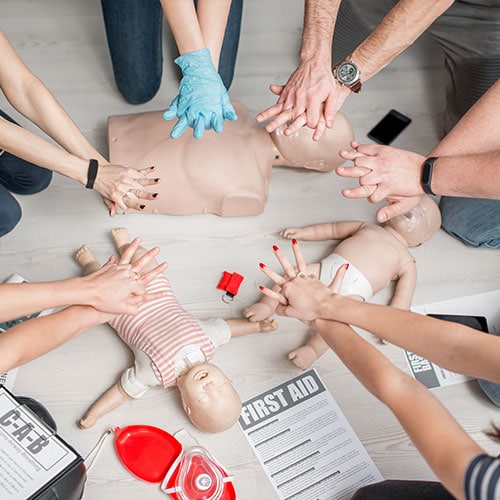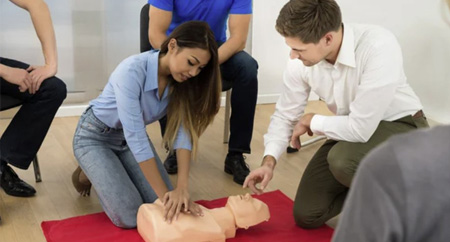Introduction
In today's globe, emergency situations can strike at any moment, and being prepared is vital. One of the vital abilities that can conserve lives is cardiopulmonary resuscitation (CPR). Young adults stand for a crucial populace that can be educated to react efficiently in emergency situations. By equipping them with CPR training, we not only equip them with life-saving abilities but additionally foster a culture of preparedness and responsibility. This post Adelaide first aid and CPR courses explores the significance of CPR training for teens, what to anticipate in emergency treatment programs, and how these skills contribute to their personal development and neighborhood safety.
Understanding mouth-to-mouth resuscitation Educating for Teens: Preparing the Future Generation for Emergencies
What is CPR?
Cardiopulmonary resuscitation (MOUTH-TO-MOUTH RESUSCITATION) is a lifesaving method made use of during emergencies when a person's heart beat or breathing has stopped. It contains breast compressions and rescue breaths that help preserve blood flow to important body organs until specialist medical aid arrives. Recognizing the fundamentals of CPR is critical for teens that may locate themselves in emergency situations.
Why Do Teens Required Mouth-to-mouth Resuscitation Training?
Teens are frequently at social gatherings, sports events, or even home events where emergency situations may occur. By discovering mouth-to-mouth resuscitation, they become positive participants of their community that can act decisively throughout situations. The capacity to perform CPR with confidence can transform a potentially terrible scenario right into one where lives are saved.
Benefits of Emergency treatment Courses for Teens
First help programs do more than just show participants how to offer immediate treatment; they infuse confidence and enhance analytical skills. For teenagers, this experience can develop personality and encourage leadership high qualities.
- Empowerment: Understanding of emergency treatment and mouth-to-mouth resuscitation encourages young people. Confidence Building: Effectively finishing a training course supplies teenagers with a feeling of achievement. Community Solution: Trained teenagers can offer in different setups such as institutions or sports teams.
The Framework of mouth-to-mouth resuscitation Courses for Teens
Course Period and Format
Most emergency treatment courses are designed to fit within a couple of hours to a number of days, depending on the deepness of training provided. Usually, a basic emergency treatment course will certainly cover:
- Theory: The principles behind emergency treatment techniques. Practical Skills: Hands-on practice with mannequins or through simulations.
Key Elements Covered in First Aid Courses
Understanding Emergency situation Situations- Recognizing when to call for help Assessing the scene for safety
- Performing premium upper body compressions Providing rescue breaths correctly
- Learning just how to run an AED Importance of very early defibrillation
- Techniques for grownups, youngsters, and infants Recognizing indications of air passage obstruction
- Cuts and scrapes Sprains and fractures
The Relevance of Qualification in Emergency Treatment Training
Obtaining Your Emergency treatment Certificate
Completing a first aid course usually culminates in receiving a certification that confirms your abilities. This certificate offers multiple objectives:
- It demonstrates capability in emergency response. Many organizations call for accreditation for participation in particular events.
Keeping Certifications Current
Just like any kind of life ability, it is very important to keep your understanding up-to-date. Many organizations advise restoring accreditations every two years.
How Young adults Can Get Involved with Emergency Treatment Training
Finding Local First Aid Courses
Teenagers thinking about getting their first aid certification need to explore regional recreation center, institutions, or health companies that provide accredited training courses.
Helpful Resources:
- American Red Cross St John Ambulance Local health centers or health departments
Online vs In-Person Training Options
With innovations in modern technology, on the internet components have actually become popular yet may lack hands-on practice essential for genuinely grasping techniques. A blended technique-- combining on the internet concept with practical sessions-- could be most beneficial.
Creating Awareness Among Peers about Mouth-to-mouth Resuscitation Educating for Teenagers: Preparing the Future Generation for Emergencies
Peer Education Initiatives
Encouraging teenagers to share what they've discovered with their pals can magnify the influence of training programs:
- Forming study hall concentrated on emergency situation preparedness. Hosting workshops at schools or neighborhood centers.
Using Social Media as a Platform
Teens today are greatly engaged on social networks systems; making use of these channels can help spread understanding regarding the value of first aid training among peers.
Real-Life Stories That Highlight the Relevance of Mouth-to-mouth Resuscitation Educating for Teens
Case Research 1: Saving a Life at College Sports Event
A young adult learnt mouth-to-mouth resuscitation had the ability to save their close friend's life during a football suit when he fell down on the area due to cardiac arrest. Their fast thinking enabled them to provide appropriate breast compressions up until emergency situation services arrived.
Case Research study 2: Family Emergency Situation at Home
Another instance entailed siblings who had taken a first aid course together. When their younger bro accidentally choked on food throughout supper, they promptly understood what steps to take due to the fact that they remembered their training-- leading them successfully via the emergency.
Frequently Asked Questions (FAQs) About Teenager CPR Training
1. What age must teenagers start taking mouth-to-mouth resuscitation courses?
Most companies recommend starting as early as 12 years of ages; nonetheless, younger kids can also discover fundamental concepts with appropriate programs tailored to their age group.
2. How much time does it require to complete an emergency treatment course?
Training courses typically vary from 4 hours approximately 16 hours depending on material deepness-- the average being around 8 hours.
3. Are there any kind of prerequisites prior to enrolling?


4. Will I obtain qualification after completing my course?
Yes! Upon successful completion and passing any necessary assessments you'll obtain an official first aid certification legitimate for 2 years.

5. Can I take these training courses online?
Lots of institutions provide hybrid formats integrating on-line theory with needed useful sessions kept in individual-- this is recommended by market standards.
6. Is it essential to renew my accreditation periodically?
Yes! Normal recertification ensures your skills continue to be proficient and current according to present guidelines.
Conclusion
In conclusion, gearing up young adults with understanding concerning cardiopulmonary resuscitation (MOUTH-TO-MOUTH RESUSCITATION) via specialized training programs is important not only for their growth but also enhances neighborhood security overall. With effective training sources available-- from regional programs supplying detailed direction on both basic first aid strategies in addition to advanced life support methods-- it's less complicated than in the past for young people eager concerning making an impactful distinction during emergencies!
As we move forward right into an unforeseeable globe filled with challenges requiring speedy action-- allow us spend our efforts towards informing this next generation so they're prepared not just academically yet additionally practically equipped when faced versus real-life circumstances demanding immediate reactions like those requiring timely interventions such as doing efficient cardiopulmonary resuscitation (CPR).